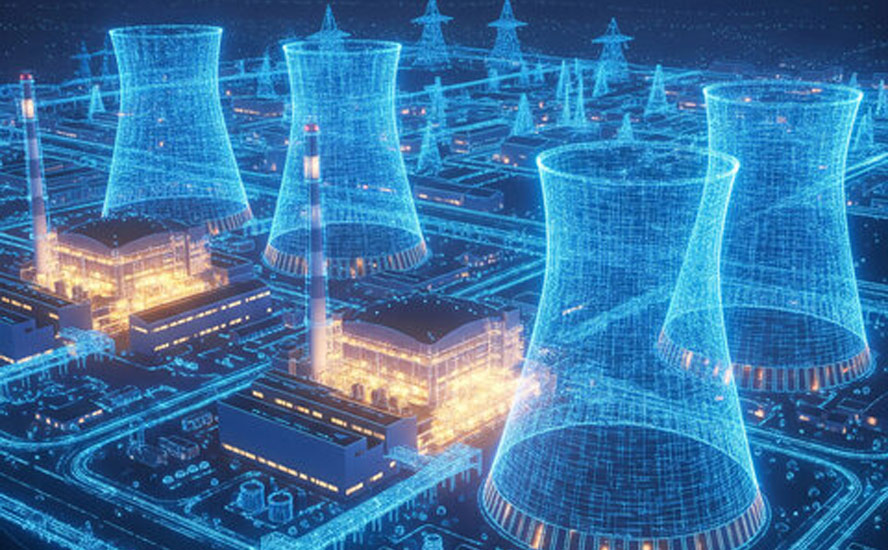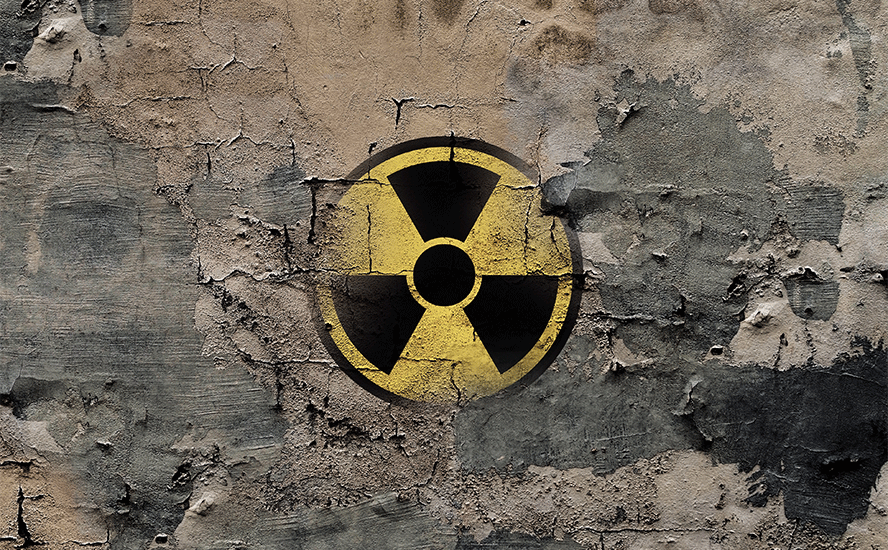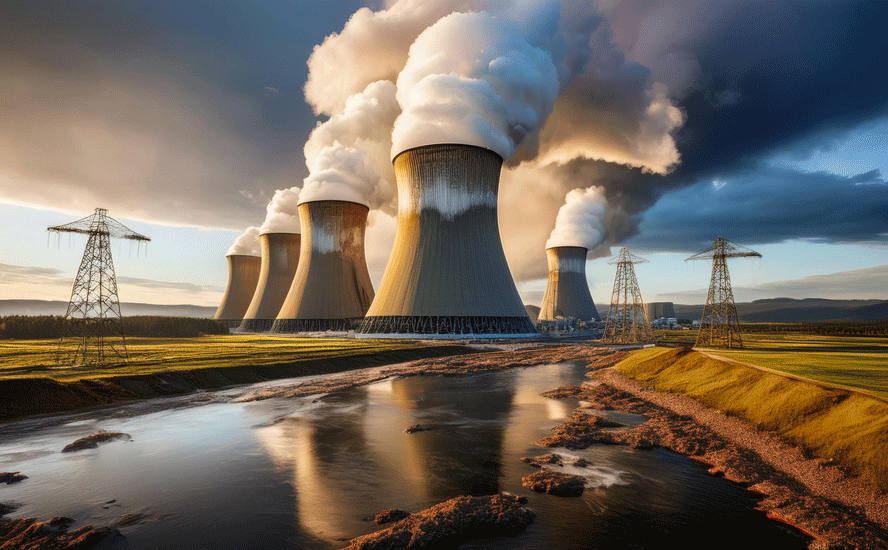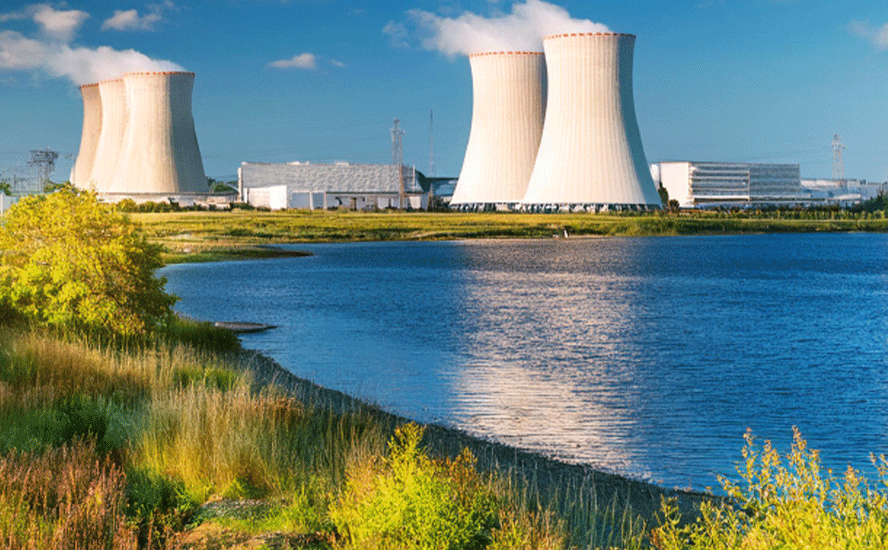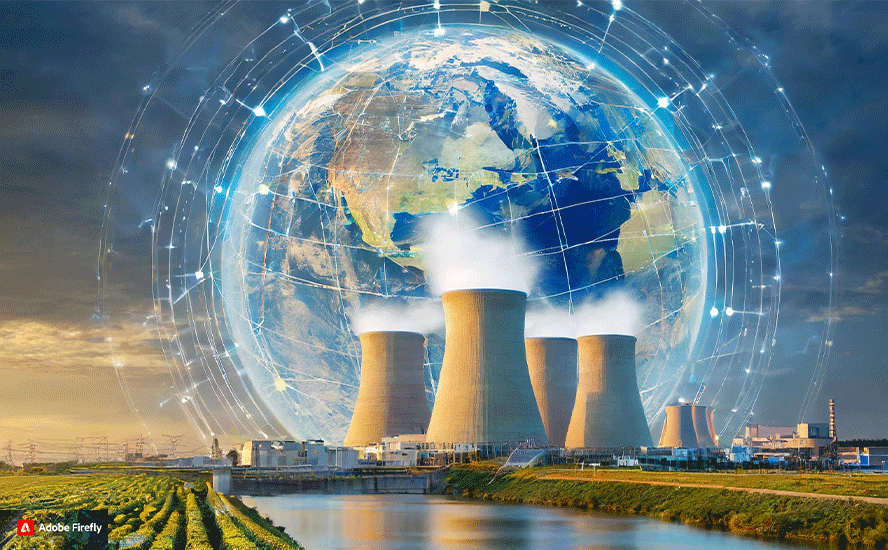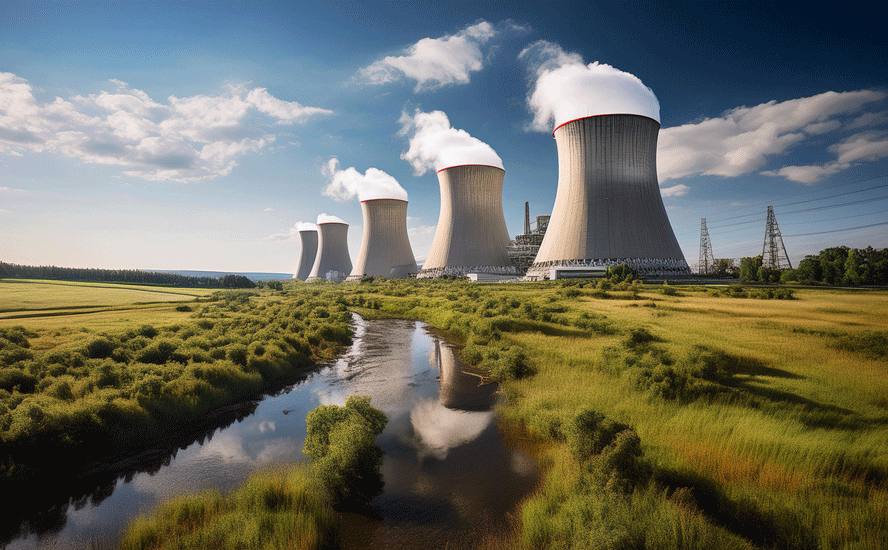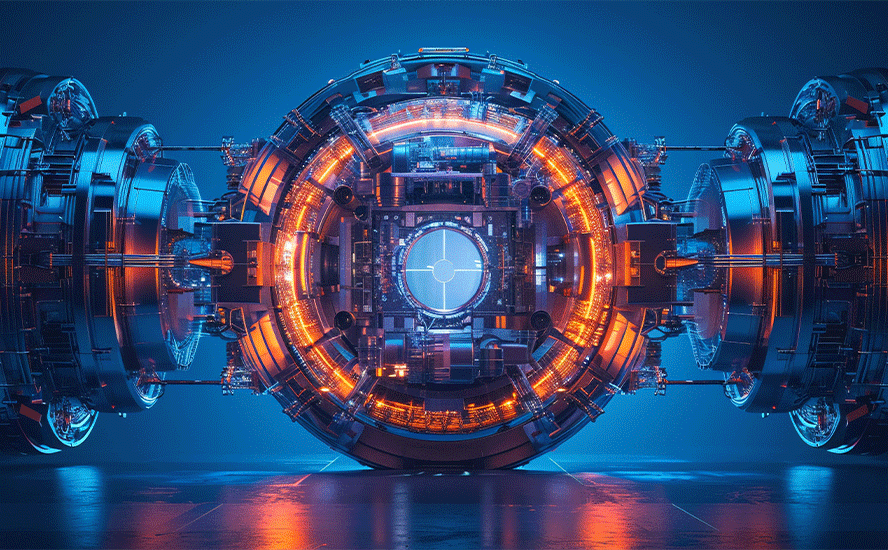Ontario, NB’s nuclear ambitions vs BC’s LNG debacle – Richard Mills
2023.10.05
The nuclear-powered energy train has left stations in Ontario and New Brunswick, speeding towards a carbon-free future.
Meanwhile, British Columbia has gone with an old clunker, hydroelectric power and natural gas, as its chosen sources of 21st century electricity.
The cost of building a Site C, a massive hydroelectric dam on the Peace River, is now estimated at CAD$16 billion, following numerous cost overruns.
BC taxpayers will also cough up $5.3 billion worth of tax breaks for a liquefied natural gas (LNG) plant and pipeline called LNG Canada — three more LNG projects are proposed, all connected by pipelines, to ship natural gas fracked from BC gas fields to customers in Asia.

Shell’s LNG Canada includes two processing trains, with room to add two more. The first two trains would have capacity for 6.5 million tonnes of LNG per annum, with four trains producing 26Mtpa. As of July 2023, the project was 85% complete.
The estimated cost is $42 billion, making it the largest private sector investment in Canadian history.
That’s $58 billion for Site C and LNG Canada put together.
What powers the batteries?
At Ahead of the Herd, we’ve been consistently beating the drum of energy metals needed to make the transition from carbon-based forms of energy to those using cleaner inputs, i.e., renewables, hydroelectric and nuclear.
On the one hand we need a lot more electricity for growing populations, and to keep up the lifestyle we’ve become accustomed to. We are addicted to oil, oil by-products and natural gas. On the other hand, we are facing a climate warming crisis of apocalyptic proportions. The problem is so big, with so many aspects, that governments, driven by self-interest, are unwilling and unable to cooperate to find solutions (other than vague unmeetable pledges to limit global temperature rises) — leaving businesses to pick away at the edges of it.
But we have another problem.
Even if we did accept that 100% electrification of our global transportation system is a necessary part of the solution to slow global warming, and to clean up our planet, it doesn’t solve the issue of the batteries.
Without a way to generate all that extra electricity needed to power the expected 1 billion electric vehicles on the road, from the current 26 million, we are no further ahead.
Last year the amount of money invested in decarbonizing the world’s energy system surpassed a trillion dollars for the first time. 2022 was also the first year that the $1.1 trillion which poured into the energy transition matched the $1.1T global investment in fossil fuels.
Green energy investment matches fossil fuels for the first time
Solar and wind are great, but renewables, despite their costs dropping, still have the intermittency problem; they can only produce power when the sun shines or the wind blows. They also come with far less energy intensity than fossil fuels and nuclear, as we argue below. Hydroelectricity is also clean energy, but we can’t be damming any more rivers.
There needs to be a way to store the energy for future use. Battery storage technology is progressing, and will most likely involve lithium-ion batteries, but we’re not there yet. We need to act quickly before the effects of global warming worsen more than they already have. I’ve concluded that the only way to achieve the necessary “bang for the buck”, while not adding to carbon emissions, is nuclear power. Bottom line? Ontario and New Brunswick get it, BC doesn’t.
Ontario’s nuclear expansion
Ontario is representative of a change in attitude towards nuclear power here in Canada, where demand for electricity is forecast to double in the next 25 years.
Having the most population, Ontario is home to all but one of the country’s 19 nuclear reactors, but most were built from the 1960s to 1980s. The Bruce Power expansion project, adding 4.8 gigawatts of capacity, is expected to be Ontario’s first in 30 years.
“We are returning to our nuclear roots, and it couldn’t happen at a more important time,” John Gorman, president of the Canadian Nuclear Association, recently told Bloomberg. As global demand for clean energy soars, Canada is once again poised to be a supplier of nuclear reactors domestically and internationally, he added.
The announcement signifies a reawakening of an industry that has been paused for decades amid concerns of safety and cost overruns.
Despite the three nuclear accidents that have occurred over the past 50 years, nuclear power is extremely safe — certainly safer than transporting and burning coal, oil or natural gas. The Fukushima Daiichi nuclear power complex was poorly placed, as it turns out, right in the middle of tsunami alley. Three Mile Island never really melted down; the design of the reactor was old, now obsolete. Chernobyl was also a poor design. The people running it were untrained and often intoxicated.
The idea that nuclear power is unsafe has been tainted by these three incidents, unfairly in my view. The ‘Exxon Valdez’ oil spill, imo, did more environmental damage than all three nuclear accidents combined.
According to the World Nuclear Association, Chernobyl involved an intense fire without provision for containment, and Fukushima Daiichi severely tested the containment, allowing some release of radioactivity. These are the only major accidents to have occurred in over 18,500 cumulative reactor-years of commercial nuclear power operation in 36 countries…
Of all the accidents and incidents, only the Chernobyl and Fukushima accidents resulted in radiation doses to the public greater than those resulting from the exposure to natural sources…
Apart from Chernobyl, no nuclear workers or members of the public have ever died as a result of exposure to radiation due to a commercial nuclear reactor incident.
When it comes to providing clean energy, nuclear power is almost flawless, as it generates electricity via nuclear fission rather than burning fossil fuels, leaving no carbon footprint.
Nuclear power plants produce no greenhouse gases during operations, and over the course of a life cycle, they produce about the same amount of carbon dioxide-equivalent emissions per unit of electricity as wind, and one-third of the emissions per unit of electricity as solar, according to the World Nuclear Association.
Energy for Humanity states that, Whilst air pollution from fossil fuels is responsible for an estimated 7 million deaths per year, nuclear carries about the same risk as wind power and is around 350 times safer than coal.
In fact, when you take into account the risks associated with greenhouse gas emissions, then nuclear comes out as safer and cleaner than both hydropower and biomass.


On top of keeping the air clean, the land footprint of nuclear plants is smaller compared to solar or wind farms. A typical 1,000-megawatt nuclear facility in the US needs a little more than one square mile to operate, while wind farms require 360 times more area, the National Emissions Inventory estimates.
Compared with fossil fuels and other renewables, nuclear’s reliability cannot be stressed enough.
Nuclear plants operate at much higher capacity factors, meaning they run at maximum power for a longer time, and can produce energy more readily. In fact, nuclear boasts the highest capacity factor of any other energy source — producing reliable, carbon-free power more than 92% of the time — the US EIA finds.

In the US, nuclear power plants operate non-stop, generating nearly 20% of the nation’s electricity. Meanwhile, renewables like wind and solar are considered intermittent energy sources, and have very low capacity factors (under 40% for both in the US), implying they are not able to provide energy even half the time.
Nuclear fuel is also extremely dense. One uranium fuel pellet can create as much energy as one ton of coal, 149 gallons of oil or 17,000 cubic feet of natural gas. A typical nuclear reactor produces about 1.5-2 times more power than natural gas and coal units, and is 2.5-3.5 times more reliable than wind and solar plants.

While some countries, such as Germany, Spain and Switzerland, are planning nuclear phase-outs, here in Canada we are more open to it.
An Angus Reid poll released in January found that 57% of Canadians surveyed would like to see further expansion of nuclear energy. Shachi Kurl, president of the Angus Reid Institute, told CTV News the “ongoing climate change discussion” with the subsequent desire to transition away from the oil and gas sector over the long term is part of the reason why we are seeing “more openness to nuclear energy” than we have in the past in Canada.
Meanwhile the Canadian government plans to mandate a net-zero power grid by 2035, and nuclear power is likely to be at the forefront.
A study by the Ontario Society of Professional Engineers modeled eight different scenarios for creating a net-zero electricity supply by the target year and found that expanding both nuclear capacity and long-term electricity storage is the best way to keep rates low.
Ontario alone will need to spend about CAD$400 billion to double its generating capacity to 88.4 gigawatts by 2050, according to the agency that runs the province’s electricity grid, as drivers switch to electric vehicles and homes/ businesses move away from fossil fuels.
The Independent Electricity System Operator looked at how to meet demand while ensuring the province’s grid is emissions-free by 2050. In a report, IESO envisions building 17,800 megawatts of new nuclear power, roughly equivalent to another Bruce nuclear plant, two more Darlingtons and an additional Pickering, reports CBC News.
In fact, the Ford government has indicated that nuclear energy will supply the biggest portion of Ontario’s additional power needs. Among its pro-nuclear moves, the province announced it wants to nearly double production at Bruce Power; unveiled plans to add three more small modular reactors to the one already being built at the Darlington Nuclear Station; and Ontario Power Generation (OPG) filed a feasibility study with the department of energy to refurbish Pickering, the country’s oldest operating nuclear power plant.
Todd Smith, Ontario’s energy minister, says there is no way Ontario can ramp up electricity production without expanding nuclear power.
“Given the fact that we want to make sure that we’re building emissions-free sources of electricity, really the best way to do that is base-load power through nuclear,” he recently told CBC.
“We’ve proven that it’s reliable 365 days a year, seven days a week and 24 hours a day,” said Smith. “That’s why we’re moving forward rather aggressively on SMRs and potentially new large nuclear as well.”
In 2022, nuclear provided just over half (54%) of Ontario’s total electricity supply. Hydroelectricity accounted for 26%, natural gas plants 10%, and other sources including solar and biofuels <1%.
Its relatively clean energy mix (90% comes from non-fossil-fuel sources) is credited for attracting Volkswagen and Stellantis to build electric vehicles and EV batteries in the province.
The next likely step in Ontario’s nuclear future is a decision on refurbishing four of Pickering’s nuclear reactor units, which are now around 40 years old. OPG is reportedly midway through the $12.8-billion refit of four reactors at Darlington.
New Brunswick’s Stable Salt Reactor
Meanwhile in New Brunswick, the provincial government has committed $10 million towards building a “nuclear research cluster” that includes a demonstration Stable Salt Reactor – Wasteburner (an SSR-W is suitable for grid-scale power, between 300 megawatts and 3GW) to be powered by spent uranium. A full-sized SSR-W is planned for 2030.
According to the manufacturer, the UK’s Moltex Energy, a 1-gigawatt SSR reactor would cost $2 billion. New Brunswick’s planned SSR and BC’s Site C are of equivalent size; the $16B Site C has a design capacity of 1.1GW compared to 1GW for the $2B SSR.
That means New Brunswick’s plan for future emissions-free, green power is eight times cheaper, in capital costs, than BC’s Site C hydroelectric dam, and nearly 24 times less than the cost of LNG Canada, including tax breaks.
LNG is also a lot worse for the environment, as we shall prove. When will the people of BC wake up and see what a colossal mistake the province is making in embracing liquefied natural gas?
The strategy to build an SSR “Wasteburner” reactor comes via New Brunswick Energy Solutions Corporation, a joint venture formed in 2017 by the provincial government and NB Power, which operates the Point Lepreau nuclear power plant. New Brunswick is the only province outside of Ontario that uses nuclear power — the generating station near the Bay of Fundy has a capacity of 705MW.
Although the plant provides 40% of NB’s energy, reliability has been an issue with unscheduled maintenance shutdowns happening in each of the last four years, a Global News video states. The province has plans for two small modular reactors to come online at the end of this decade and beginning of the next built by Moltex and Arc Clean Energy, who have received about $30 million from the province to aid development.
The idea is to build a demonstration SSR-W plant at Point Lepreau, as part of a nuclear cluster that will research the development of small, modular nuclear reactor technology in New Brunswick. As mentioned, the plan is to up-size the reactor to full size by 2030.
“The Moltex stable salt reactor technology is a perfect fit for New Brunswick’s power needs,” Moltex CEO Stephen Haighton said in a press release. “It uses spent nuclear fuel, which could help solve the province’s future spent-fuel disposal challenge. It is a physically small modular reactor but is able to store energy, so can double or triple its output at peak demand times during the day. Most importantly, the stable salt reactor technology produces very low-cost, clean energy and can reduce the cost of electricity to consumers while achieving low-carbon targets.”
According to Thorium Energy World, SSR technology is able to store grid-scale energy, allowing the power plant to output peak power to the grid for several hours, at three times the reactor’s power, during periods of peak demand.

The SSR reactor generates power through convection, from static vertical tubes in the core, to convey heat to the steam generators.
Unlike conventional nuclear reactors, under Moltex Energy’s design, SSR reactors do not need expensive containment structures. They are also safer, because they do not contain harmful gaseous by-products like caesium-137 and iodine-131, which escaped during the Chernobyl accident. Instead, the reactors contain non-volatile salts, which cannot leave the reactor.
The reactor core is composed of modules with 10 rows of 10 fuel assemblies, sitting in a tank of coolant salt. Each fuel assembly contains nearly 400 thin fuel tubes, just 10-mm in diameter. A key point about SSRs is their portability; a 1,200-megawatt reactor could fit on the back of a truck, according to Moltex.
The fuel is composed of two-thirds sodium chloride (table salt) and one third plutonium (spent uranium fuel) with mixed lanthanide/actinide trichlorides. This is another advantage of an SSR versus a water-cooled reactor. Instead of burying the spent nuclear fuel deep underground until its radioactivity levels are considered safe, the reactor burns plutonium — thus providing a feedstock for spent nuclear fuel and therefore a solution for dealing with spent nuclear waste that would otherwise have to be stored underground for thousands of years.
Thorium World states that the SSR-Wasteburner leaves radioactive waste that has a half-life of 300 versus 300,000 years. According to Moltex, SSR designs include a uranium burner (SSR-U) that would burn low-enriched uranium, and a thorium breeder (SSR-Th) which contains thorium in the coolant salt that can breed new fuel.
BC’s LNG boondoggle
While New Brunswick researches a plan to augment its existing nuclear power, and Ontario refurbishes old reactors and builds new nuclear capacity, British Columbia is inviting more natural gas development as it moves forward on a liquefied natural gas industry first proposed by the BC Liberal government.
The NDP, re-elected in 2020, two years earlier approved a $40 billion project by LNG Canada, for an LNG compression facility in Kitimat, and a pipeline that would run from the Montney natural gas play to the Kitimat plant.
The project is the biggest new liquefied natural gas facility approved globally since Russia’s Yamal project in 2013.
The NDP also approved Site C, the dam being built on the Peace River in northeastern BC. BC Hydro, the Crown corporation, is on the record as saying that at least three LNG companies will need power from Site C. In other words, yes we will need the power, but not for BC residents; it’s for the LNG industry.
The natural gas, when it arrives at the terminal, is unsuitable for transport. To turn it into a liquid, it must be cooled to 163 degrees below zero. To do that requires a great deal of power, with massive compression units running 24/7.
40% of Site C
It’s estimated that if LNG Canada were to use only hydroelectric power to convert NG to LNG, would require 40% of the capacity of the Site C dam currently being built.
Fracked gas
Where does all the natural gas to be compressed into liquid form come from? It comes from BC’s natural gas reserves, extracted from the northeast corner, mostly from the Montney tight gas play – which contains more gas than four of the largest fields in the US.
The natural gas for LNG Canada will be fracked gas, because almost all of BC’s conventional gas reserves are depleted.

We all need to remember, extracting natural gas through hydraulic fracturing, transporting it to a terminal, and then cooling it for shipping in tankers, is not clean energy; in fact it’s as dirty, or dirtier than coal.
According to two reliable sources, methane from the production of natural gas makes LNG about as bad a greenhouse gas emitter as coal, and that when it comes to lifecycle GHG emissions, LNG sometimes emits more than coal.
Contrary to the industry’s message, there is also no evidence that LNG exports would reduce coal use around the world. A recent report found that China is building six times more coal plants than other countries.
“The BC government is missing a key point when it comes to recognizing the value of LNG in fighting climate change,” says Matt Horne, BC associate regional director for the Pembina Institute. “Without a global push for low carbon energy sources and efficiency, LNG will likely worsen rather than ease global warming.” (Pacific Institute for Climate Solutions, Oct. 27, 2014)
To turn it into liquid form, the gas must be cooled to 163 degrees below zero. To do that requires a great deal of power, with massive compression units running 24/7. Where does that power come from? In most cases, the same fracked natural gas is used to run the compression units, which defeats the purpose of LNG as “clean”.
According to Wood Mackenzie, LNG will be the biggest source of carbon emission growth by 2025 – due to strong demand from Asian buyers.
Emissions from the first and second phase would represent nearly three-quarters of the province’s legislated target for greenhouse gas emissions in 2050, set at 13 megatonnes/yr.
Opponents say the project will blow the NDP’s goal of cutting GHGs by 40% by 2030 and 80% by 2050, out of the water.
Health and environmental effects
We have written extensively on the negative effects of natural gas on human health, the environment and fresh water supplies. There’s also the damage done to marine mammals due to a significant increase in LNG tanker traffic, including to BC’s majestic killer whales. For a detailed discussion, click on the links below.
BC’s LNG boondoggle continues to lack critics
There is no way the BC government is going to be able to meet its climate change goals, due to LNG Canada. The province has committed to cutting greenhouse gases by 40% by 2030 (and 80% by 2050) but LNG Canada would produce 3.45 megatonnes of carbon a year. And that’s with just the first phase; the plan is to double the gas output.
British Columbia could have rejected LNG, based not on politics but sound science (as we have), and pinned its low-carbon energy future instead on existing hydroelectric power, with the addition of one large or several smaller nuclear reactors.
An excellent example is the SSR-Wasteburner reactor planned for New Brunswick fueled by depleted uranium.
However, any notions of a nuclearized BC are dispelled in the Clean Energy Act which states the intention “to achieve British Columbia’s energy objectives without the use of nuclear power.” Also, BC since 1980 has had a ban on mining uranium — the fuel for nuclear reactors.
Power limitations
During its first phase, LNG Canada could use 40% of the power produced by Site C. If the consortium goes ahead with Phase 2, it will consume 80% of the dam’s power.
Given these figures, it’s well worth asking, does the province have enough power capacity for all its future energy needs? A University of Victoria study quoted by Resource Works found that if BC wants to electrify all road vehicles by 2055, it will need to at least double its power output.
Energy commentator Markham Hislop of Energi Media weighs in: “By 2050, BC may need to double or triple its… power generation as transportation, buildings and industry are all or partially electrified. Current output is generated with 32 hydro dams. Can the province build another 32 or 64 hydro plants in under 30 years? Of course not, so where will all that power come from?”
In the short term, we can expect high greenhouse gas emissions to be generated from LNG Canada. Why? Because until the hundreds of kilometers of new transmission lines are built to reach the province’s remote northwest coast, the facility will be forced to use natural gas turbines, instead of hydroelectricity, to liquify the gas.
Conclusion
In British Columbia, and throughout the country, we are facing pressures to go green. At the same time, a growing population demands more electricity. A lot more. According to the provincial government, BC’s population is expected to grow from 5.1 million in 2020 to 6.5 million in 2041, an increase of 27.5%.
Then-Premier John Horgan decreed that all new light-duty cars and trucks sold in BC must be zero-emissions by 2040. In other words, no more gas-only vehicles, just EVs and hybrids.
The province is moving in a green direction, but without a plan as to how the electricity will be generated. Not only for all the electric vehicles that are supposed to replace the gas-powered ones (remember the UVic study that found if BC wants to electrify all road vehicles by 2055, it will need to at least double its power output), but the batteries. Batteries are just storage devices for energy which first must be created. We know that fossil fuels can deliver this power. So can nuclear. At this point, renewable energy can’t.
Our transportation system needs to be electrified. We can do it but we have the energy to turn into electricity. Likely we’re never going to get rid of fossil fuels but we can achieve a balance, whereby we have decent EV penetration into the ICE market, say 40%. We’re never going to achieve 100% because we don’t have the metals. Without copper, for example, there is no electrification shift.
Copper and silver: the electrical metals
If we insist on filling all those batteries and charging stations with power generated from solar and wind, we are heading down the wrong path. We live in a finite resource world and we must prioritize. The current supply of electrification metals can go into EVs but if we push renewable energy much further, we’re not going to have enough, and we’re going to drive the prices of metals so high, the end products (like EVs, cell phones, TVs, etc.) are going to be prohibitively expensive.
Nuclear, therefore, is the only option we have.
If BC built a fleet of small nuclear power plants it wouldn’t have to bother with Site C and the ever-ballooning cost of the LNG misadventure, currently sitting at $42 billion. It could also avoid the tragedy of flooding perfectly good farmland in northeastern BC and subsidizing the LNG industry at the expense of BC taxpayers.
With nuclear, a lot of metal could be kept in the ground for future use.
I see very strong possibilities in New Brunswick’s strategy to bring updated nuclear power technology to the small Maritime province. We know that nuclear has to be included in Canada’s plans to decarbonize. We also know that technology exists to shift from conventional water-cooled to small, modular reactors, that could be sited in various locations throughout the province, providing reliable baseload power at a fraction of the cost of traditional reactors feeding a large grid.
We could build one 1,000 megawatt Stable Salt Reactor for $2 billion. Site C, so far, is costing BC taxpayers $16B for 1,100 megawatts.
But remember, 40% of Site C is already allocated to LNG Canada. Where is the power to electrify every vehicle in the Lower Mainland going to come from?
Consider: the number of EVs on BC roads over the past six years has exploded by nearly 2,000%! Electricity demand is expected to increase by 15% between now and 2030; Site C isn’t finished, yet BC Hydro is planning next year on launching a call for new green power sources. (SiteNews, June 16, 2023). In other words, by the time Site C is operational, it will already be obsolete; much more power is needed.
How are we going to get it? The answer should be nuclear. As we rapidly run out of electricity while demand for it surges, and the province continues to be ravaged by forest fires, floods and other manifestations of global warming that are costing billons of public funds, we had better start thinking like Ontario and New Brunswick.
Site C is a boondoggle. It was never going to be enough to meet our energy needs, especially with 40% of its power capacity going to turn fracked natural gas into LNG that is then shipped to Asia. The folly is we’re subsidizing energy in China while being stuck without the electricity needed, fooled by our smooth-talking politicians who carry out their touch-feely plans to go emissions-free.
We’re flooding perfectly good farmland so the Lower Mainland has enough electricity to drive EVs. That isn’t green, and neither is the plan to develop a liquefied natural gas industry in northern BC.
Richard (Rick) Mills
aheadoftheherd.com
subscribe to my free newsletter
Legal Notice / Disclaimer
Ahead of the Herd newsletter, aheadoftheherd.com, hereafter known as AOTH.
Please read the entire Disclaimer carefully before you use this website or read the newsletter. If you do not agree to all the AOTH/Richard Mills Disclaimer, do not access/read this website/newsletter/article, or any of its pages. By reading/using this AOTH/Richard Mills website/newsletter/article, and whether you actually read this Disclaimer, you are deemed to have accepted it.
Any AOTH/Richard Mills document is not, and should not be, construed as an offer to sell or the solicitation of an offer to purchase or subscribe for any investment.
AOTH/Richard Mills has based this document on information obtained from sources he believes to be reliable, but which has not been independently verified.
AOTH/Richard Mills makes no guarantee, representation or warranty and accepts no responsibility or liability as to its accuracy or completeness.
Expressions of opinion are those of AOTH/Richard Mills only and are subject to change without notice.
AOTH/Richard Mills assumes no warranty, liability or guarantee for the current relevance, correctness or completeness of any information provided within this Report and will not be held liable for the consequence of reliance upon any opinion or statement contained herein or any omission.
Furthermore, AOTH/Richard Mills assumes no liability for any direct or indirect loss or damage for lost profit, which you may incur as a result of the use and existence of the information provided within this AOTH/Richard Mills Report.
You agree that by reading AOTH/Richard Mills articles, you are acting at your OWN RISK. In no event should AOTH/Richard Mills liable for any direct or indirect trading losses caused by any information contained in AOTH/Richard Mills articles. Information in AOTH/Richard Mills articles is not an offer to sell or a solicitation of an offer to buy any security. AOTH/Richard Mills is not suggesting the transacting of any financial instruments.
Our publications are not a recommendation to buy or sell a security – no information posted on this site is to be considered investment advice or a recommendation to do anything involving finance or money aside from performing your own due diligence and consulting with your personal registered broker/financial advisor.
AOTH/Richard Mills recommends that before investing in any securities, you consult with a professional financial planner or advisor, and that you should conduct a complete and independent investigation before investing in any security after prudent consideration of all pertinent risks. Ahead of the Herd is not a registered broker, dealer, analyst, or advisor. We hold no investment licenses and may not sell, offer to sell, or offer to buy any security.
Legal Notice / Disclaimer
Ahead of the Herd newsletter, aheadoftheherd.com, hereafter known as AOTH.Please read the entire Disclaimer carefully before you use this website or read the newsletter. If you do not agree to all the AOTH/Richard Mills Disclaimer, do not access/read this website/newsletter/article, or any of its pages. By reading/using this AOTH/Richard Mills website/newsletter/article, and whether you actually read this Disclaimer, you are deemed to have accepted it.



